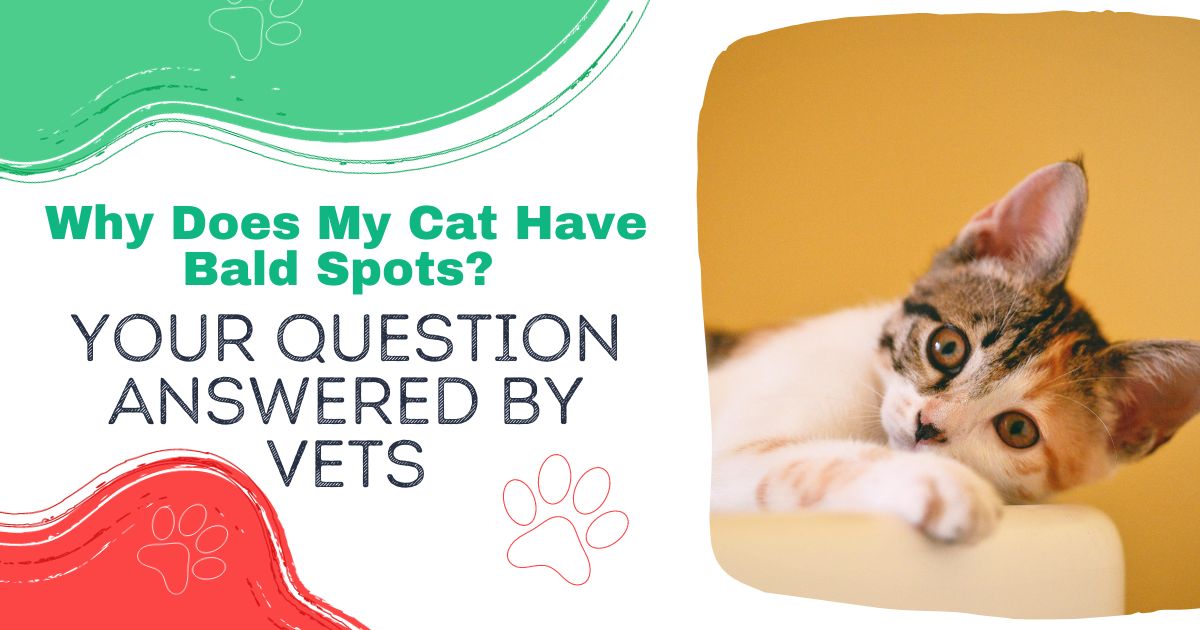Why does my cat have bald spots? Feline alopecia is the medical term for excessive hair loss in cats and is a frequent reason for consultation at the veterinary clinic. The first thing to do is identify whether it is a pathological hair loss. Seasonal hair loss is expected in felines. Outdoor cats shed twice a year, while indoor cats tend to shed year-round.
Bald Spots in Cats
Bald spots in cats are a total or partial lack of hair affecting different body areas. Alopecia can be a consequence of:
- An alteration in the production or growth of hair (hereditary). Example: Congenital alopecia in Sphynx cats.
- Excessive hair loss self-induced (Alopecia secondary to pruritus or a psychogenic disorder).
- A spontaneous excessive hair loss not self-induced by the animal (primary alopecia).
Based on these mechanisms, different feline diseases can cause fur loss in cats.
Why Does My Cat Have Bald Spots?
Primary Alopecia
It may not be pathological in certain breeds or certain body locations. For example:
- Preauricular alopecia: less hair on the fringe in front of the ears.
- Alopecia on the ear pinnae of older Siamese cats.
Or they can result from pathologies such as:
- Folliculitis (infection, immune-mediated disease).
- Para-neoplastic alopecia
- Cushing’s syndrome
Pathological primary bald spots are rare in cats compared to self-induced alopecia.
Secondary or Self-Induced Alopecia
Various diseases can cause self-induced bald spots on cats. Hair loss is the consequence of the animals’ licking or scratching. It can also occur with scabbing, skin redness, flaking, etc.
In this article, we will focus on the causes of self-induced hair loss, as it is the most common form of presentation in cats.
Where Do Feline Bald Spots Appear?
The bald spots areas can be:
Focal
The animal has one or a few hairless areas. As in cases of joint pain, the bald area is above the joint in question.
Multifocal
Cat hair loss in patches can have different sizes and shapes depending on the cause that provoked them. Felines have several bald sports areas on the body. For example:
- On the face and head in the case of mange.
- Ringworm affects the ears, head, and extremities.
- Dermatological manifestations of food allergy are on the head and neck.
- Neck and base of the tail in the case of flea bite allergy.
Generalized
When the absence of hair is extensive, most of the body is hairless. Atopic dermatitis causes:
- Bald spots on the sides of the body or the belly,
- Wounds around the head and neck,
- Recurrent otitis, and
- Generalized skin inflammation.
Psychogenic alopecia causes symmetrical hairless areas on the back of the body where the cat can lick itself.

What Causes Bald Spots on Cats?
Pruritic (intense Itching)
Ectoparasites: Fleas, Lice, and Mange Mites
Fleas are the most frequent parasites of cats and are visible to the naked eye as black spots that move fast through the feline’s fur. Another way to diagnose fleas’ presence is by visualizing little black balls stuck to the cat’s fur in the chin and neck area. As these are flea feces, we can observe that they stain red when wet.
Lice and mange are not as frequent as the previous one. Lice can also appear on the animal, but unlike fleas, they are not as fast. Mites are not visible to the naked eye; the most common in cats is in the ears.
Infections: Bacterial and Fungal
Bacterial infections are secondary to a previous injury and need appropriate treatment to allow the wounds to heal.
Fungi cause fungal infections, and “ringworm” is its familiar name. Ringworm occurs in immunosuppressed animals such as kittens or adults under stress or poor living conditions. It is a zoonotic disease, so humans can develop it.
Allergies: Food, Environmental, and Flea Bites
Allergies are becoming more common in the cat world and are noticeable through skin or hair diseases.
Some cats are allergic to flea saliva. Thus, a single flea that feeds on the cat will trigger an allergic reaction throughout the cat’s body. Allergies can also be due to proteins in the food or some environmental substance such as pollen, grass, chemicals, etc.
Others: Hyperthyroidism and Cutaneous Lymphoma
In adult cats with skin problems, include both diseases in the differential diagnosis.
Non-Pruritic (Non-Itchy)
Psychogenic
Cats are prone to stress when there is a change in their environment. A move, loud noises, the addition of another pet, or even any change in the animal’s habits can cause a cat to become stressed.
Stressful situations lead cats to develop obsessive behaviors such as excessive hair pulling and licking. Licking the fur is an endorphin releaser, making your cat feel better.
Pain
Pain resulting from trauma, musculoskeletal disorders, or neuropathies generates excessive licking by the cat to relieve discomfort.
When to Take Your Feline to the Vet
Veterinary attention is not necessary in the case of preauricular alopecia and that seen on the external part of the pinnae. In pathological primary or secondary alopecia, seeing a veterinarian as soon as possible is essential to treat the condition.
Besides, remember that some of the diseases that produce a patchy cat can be zoonotic, so it is vital to avoid the possibility of contagion by treating the animal as soon as possible.
What Do Cat Bald Patches Look Like?
In general, cat bald spot may manifest with the following characteristics:
- Hair loss
- Reddening of the skin
- Itching and scratching
- Excessive grooming
- Scaling
- Crusting
- Self-induced scratching lesions
- Lumps or blisters
Yet, some pathologies present particular characteristics.
Ringworm is a fungus that causes bald spots on cats’ heads, ears, and faces, although it can also affect the legs. It manifests by one or more circular, well-defined bald patches.
Mites inside the ears cause head tilt and shaking due to discomfort and a dark, foul-smelling otic discharge.
In hyperthyroidism, a common endocrine disease in felines, there is a loss of coat quality (due to lack of grooming habits), and the animals’ general condition is poor. Lymphoma is a rare cat tumor characterized by patches, plaques, and cutaneous nodules, with localized or generalized distribution and no preference for any body part.
The characteristic of psychogenic alopecia is that it is symmetrical, and cat hair is lost on the back near the tail, on the posterior face of the hind limbs, and the sides of the body.
Will My Cat’s Hair Grow Back?
The answer is yes, as long as the cause of the alopecia gets diagnosed and treated. It is important to remember that it will take one to two months for the hair to grow back, so be patient until your kitty looks as handsome as before!
Veterinary Treatment Plans to Combat Bald Spots in Cats
The treatment for hair loss in cats will depend on the specific cause that produced it. As the reasons are many, arriving at the proper diagnosis is very important, as each case will have a particular treatment.
The first step is to gather as much information as possible about the lesions at the beginning of the problem; which came first: the bald spots or itching? The presence of lesions on other animals or people in the household. Then, the dermatological examination should be complete and detailed to detect the presence of any alteration.
- To identify lice, mites, or fleas, comb the hair with a fine comb and use adhesive tape to get parasites, eggs, feces, or superficial skin scrapings and otic samples for microscopic observation.
Currently, flea treatment in cats is with spot-on pipettes placed on the skin of the neck. Mites need injected treatments or local antiparasitic drops.
- To check for bacterial and fungal infections, perform cytological, bacteriological, and fungal examinations. The cytological examination also may suggest non-infectious diseases that can cause pruritus, such as immune-mediated diseases or cutaneous lymphoma.
Treatment will be local with antibiotic or antifungal creams or systemic, with oral or injectable tablets.
- If the suspicion is allergic, elimination and challenge diet testing diagnose food allergies. Environmental or atopic allergy diagnosis relies on skin or blood allergy tests.
Treatment consists of eliminating the cause of the allergy. For food allergies, offer hypoallergenic foods or foods with hydrolyzed protein. In the case of atopy, remove the causative element from the environment surrounding the animal if possible. If this is not possible, use antihistamines and corticosteroids in creams, tablets, or injectables to reduce symptoms. Medicated shampoos are also a good option for cats accustomed to water.
- To diagnose hyperthyroidism, perform a blood test.
- In the case of psychogenic bald spots, suspicion arises when patients manifest excessive grooming and do not respond to antipruritic therapy. But first, rule out all causes of pruritic bald spots. Treatment consists of antidepressants or anxiolytics to help the cat cope while eliminating environmental stressors.
- If there is obsessive grooming behavior in areas of pain, administer medication to reduce this painful condition.

Prognosis and Recovery
In self-induced (secondary) scratching hair loss, the prognosis is favorable when we identify the cause that produced the bald patches in our cats and they receive adequate treatment. Recovery from the condition is rapid, yet our friends will look untidy for the first few months until their hair returns.
Primary alopecia is a symptom of a set of symptoms of severe and complex diseases. In this case, the prognosis remains guarded because of the severity of the picture.
At-Home Treatment for Cat Hair Loss
- Weekly brushing of the hair
- Adequate internal and external deworming
- Avoid contagion by isolating the sick cat
- Balanced and good quality food
- Decrease stress factors
That’s a Wrap
Remember that the well-being of your kitten includes the care of its skin. Try to keep it healthy and, above all, in the best condition.

Diana is a veterinarian, who graduated in 2006 from the University of Buenos Aires (Argentina). She moved to Mexico in 2010 and revalidated her degree at the National University there. Now she lives in the Mexican Caribbean with her partner and their 3-year-old son. She has worked with domestic animals, also with cheetahs in Africa, and in wildlife zoos in Argentina and the US. In addition, she has experience working with exotic pets and marine mammals. These days she has fun playing on the beach with her son when she is not caring for animals.
Source link: https://iloveveterinary.com/blog/why-does-my-cat-have-bald-spots-your-question-answered-by-vets/ by Diana Wells at iloveveterinary.com






